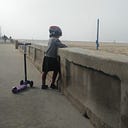LADOT in 4 Minutes
This article discusses the history and current activities of LADOT. It is part of a series that provides short guides to different governmental transportation organizations in LA and CA.
Formal Name: Department of Transportation (DOT)
Budget: Department budget = $187 million (FY2019); Special funds managed = $565 million (FY2018).
Staff: roughly 1400 positions
What LADOT Does: Manages mobility on the street.
If BOE builds streets and StreetsLA maintain LA’s streets, then LADOT oversees the primary way the street gets used.
This can be a tricky discussion, since the existing design of the street (via BOE) dictates a lot about how a street will get used, as do the land uses that line the street (via City Planning) and even the condition of the street (via Streets LA). LAPD certainly can influence how a street gets used as well, given that they can hand out tickets and arrest people.
But at least officially, LADOT has “centralized authority over the conceptual planning and operation of the City’s streets and highways systems.”
History
The story of LADOT is quite interesting. Here’s the short version, which I’ve adapted from Matthew Roth’s excellent historical essay in this book:
- Early on, management of traffic and parking in Los Angeles was performed by the police department. Thus when the city created Bureau of Traffic Engineering in 1930, it was placed under the Police Commission.
- In the early 1950’s, the City Council elevated the importance of traffic management by establishing a new Traffic Department. This new department covered traffic studies, the design and installation of traffic signs and traffic signals, the management of parking meters, and permits for commercial vehicles.
- In 1979, after years of intense debate and pushback from other city departments, the Council and Mayor made the pivot from “traffic” to the more comprehensive concept of “transportation” with the inauguration the Department of Transportation (LADOT). This new Department absorbed the following transportation-related functions from other departments:
- most transportation planning (from LADCP)
- street-improvement studies (from BOE)
- traffic and parking enforcement (from LAPD)
- oversight of franchises for buses, taxis, and ambulance companies (from the Board of Public Utilities).
This shift from “traffic” to “transportation” in 1979 was significant: even if only on paper, it symbolized a more holistic approach to all the ways people move around instead of the narrow focus on how cars can get around. Most city departments don’t like losing positions, funding, and authority, which is why all of the departments above resisted this attempt at centralization of transportation activities. But the overall objective was to better harmonize the many modes people use everyday, which include walking, biking, public transit- and of course, driving.
Current Operations
In the present era, LADOT develops comprehensive plans for the city’s transportation network by crafting a vision of transportation that the city can work towards in the future. These plans say which uses should be prioritized on which streets- even if they aren’t used that way right now- and which policies should be implemented to move towards a better mobility system throughout the city.
Of course, DOT’s plans are nonetheless just a vision- they still require communities, other city staff, and elected officials to work together to fulfill them.
On a more day to day basis, DOT oversees projects to improve how streets operate. Their primary tools are paint, signs and signals- with these instruments they can dictate a lot about how a street gets used. Interestingly, some of the most contested transportation decisions in the city are not related to multi-million dollar infrastructure projects, but rather concern the simple placement of paint on the street that would redesignate space to a new use- like for buses and bikes.
An important note- about 45% of LADOT’s budget is devoted to parking: parking meter and parking lot operations, parking enforcement, parking permit issuance, and the processing of parking citations. While City Planning sets parking requirements for the “private” buildings and their parking lots along the street, DOT manages parking for the “public” spaces on the street and those in city-owned parking lots. It is in its capacity as manager of parking spaces that DOT oversees the People Street program that converts parking spaces and under-utilized street space into parklets and plazas.
DOT also provides a grab-bag of other services, such as providing crossing guards for schools, traffic officers for emergencies and special events, and it runs the DASH shuttle and commuter bus services that supplement the city’s core bus service that is provided by LA Metro.
Similar to Streets LA, DOT has a large proportion of employees that are physically out in the streets everyday- conducting traffic, issuing parking citations, or driving buses. They have a relatively smaller number of planners and engineers, though these roles are essential for executing important transportation initiatives like the Vision Zero and Safe Routes to School programs and delivering selected infrastructure projects.
Go here for the main page of this transportation series.
